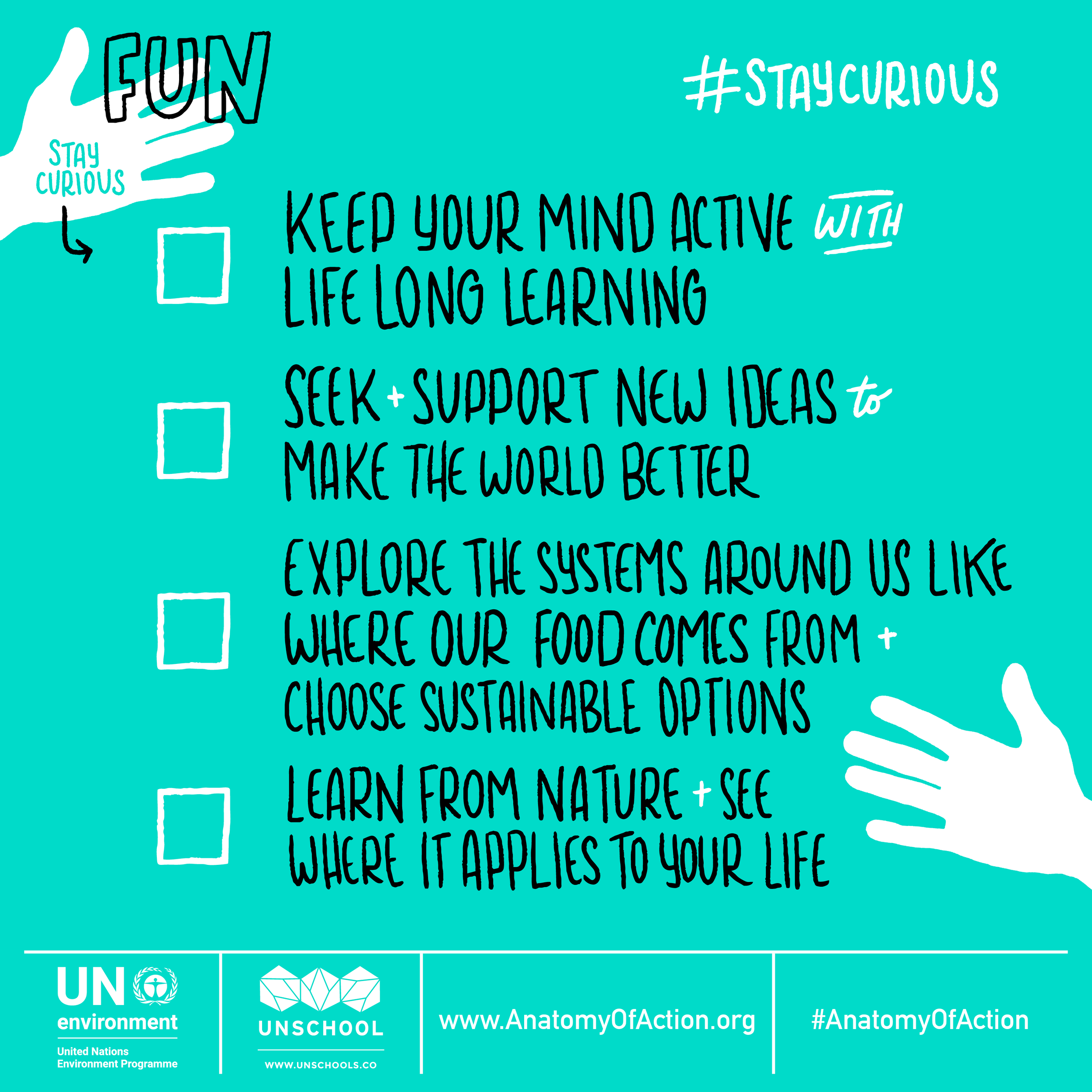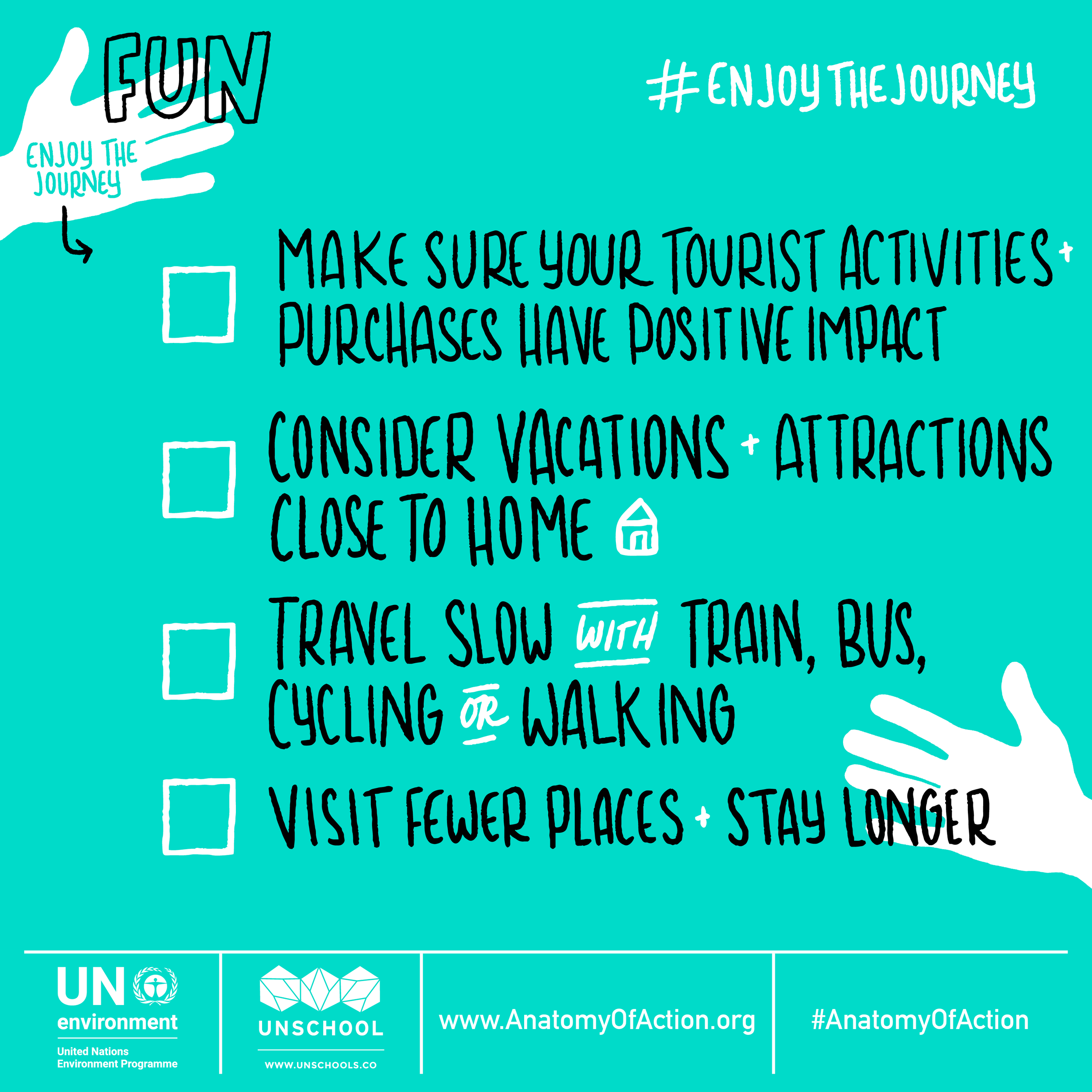Let’s be honest — being a creative problem solver can be completely overwhelming and totally exhausting. From negativity bias to creative burnout through to compassion fatigue, there are many hurdles that can result in spending personal energy trying to make the future better than today. And then when we want to take a break from it all, there’s another thing that us sustainability-focused humans will consider, too: the impacts of our travel and leisure. Add in the negative stigma of sustainability that many people associate with going back to ‘the dark ages,’ and now we have a lot of confusion around how to kick back, enjoy ourselves, and have some fun. If you’ve been following our work at the UnSchool for a while, then you may know how much we value fun (if not, watch this or this to get some insight). So, it was very important to us to look at how we can have fun in a better way through the Anatomy of Action.
Action 1: Enjoy the Journey
Being an ethically-conscious traveller can have positive impacts on the communities you are visiting and on your personal well-being. Opting for a “staycation” vacation near your home — preferably in nature — can be rewarding for your health, the local economy, the environment, and, of course, your wallet! If you’re not into staying in your own house, consider an AirBnB; its sharing model has been found to make better use of existing resources. Aching to venture out a bit? A short road trip is also a more sustainable way to travel than flying. As environmental author Kate Galbraith noted in this NYT column, “The second-best thing to staying home — a more generous definition of staycation — is venturing just a few hours away, to a park or town that you haven’t already seen many times. The quick trip can seem as if you’re a world away, without the hassle of navigating a Transportation Security Administration screening or a long stint in the car.”
Many people want to see the world — so much so that “tourism’s global carbon footprint has increased from 3.9 to 4.5 GtCO2e, four times more than previously estimated, accounting for about 8% of global greenhouse gas emissions.” And, many emerging economies depend on tourism revenues, small island development states in particular. So if you go the distance, or if you travel for sun and surf, first opt to stay longer, since take off and landing are the most polluting parts of a flight. Secondly, eat local: according to the UN, “Food is the second largest C02 emitter in the tourism industry. In small islands like Mauritius, 98% of food is imported. Asking people to enjoy local foods will be both beneficial for the planetary and the social aspect.” Of course, you’ll also want to ditch disposables and be proactive in your footprint.
#EnjoyTheJourney Everyday Actions
Research and ensure your tourist purchases and activities have a positive impact wherever you go
Consider vacations close to home and see the things that other people travel to your community to see
Travel slowly and take time to discover by taking the train/bus or cycling and walking
Visit fewer places but stay longer in each
If you take flights over 6000 km, travel through hubs rather than direct and consider staying close to the venue to reduce travel time
Experience the real: eat and stay local, embrace diverse cultures, experience what the terrain has to offer (run, bike, hike), and help local economies
Refuse disposable plastics and other single-use items and minimize your visit’s impacts
Collect memories from your trip that leave footprints in the sand, not on the planet - be mindful and proactive about the impacts of your fun times
Action 2: Stay Curious
Learning, curiosity, discovery, wonderment — whatever you want to call it, life is made more valuable (and fun!) through the addition of new knowledge, ideas, and actions. This does not mean you have to enroll in a professional learning program or institution; learning opportunities are everywhere, and we can choose the medium that works best for us, as this Harvard Business Review article points out: “Books, online courses, MOOCs, professional development programs, podcasts, and other resources have never been more abundant or accessible, making it easier than ever to make a habit of lifelong learning. Every day, each of us is offered the opportunity to pursue intellectual development in ways that are tailored to our learning style.”
By embracing curiosity, you can gain all sorts of lifelong benefits, from a more flexible outlook on life and work, all the way to setting a better example for our kids and communities. You’ll also be better prepared for the future, as everything around us is constantly changing: “Trends including AI, robotics, and offshoring mean constant shifts in the nature of work. Navigating this ever-changing landscape requires continual learning and personal growth.” And, staying curious is good for your brain! Studies are proving how engaging your learning superpower can stave off age-related cognitive and memory decline.
Finally, learning is a great way to enhance your social life because it helps foster relationships and can introduce you to like-minded peers (especially if you take a workshop or volunteer for a cause, for example). This is an increasingly important point to consider since we have become increasingly factioned and isolated within our hyper-busy societies; in the US alone, an estimated 42.6 million adults over age 45 are thought to be suffering from chronic loneliness. This isn’t just a social or cultural issue — loneliness actually has a physiological impact “via stress hormones, immune function and cardiovascular function with a cumulative effect.” Some officials even believe that loneliness poses a greater risk to public health than obesity! So, when you take up learning new things, consider being intentional about finding a way to integrate social interaction to help build meaningful relationships along the way.
#StayCurious Everyday Actions
Adopt a lifelong learning approach to keep your mind thirsty and active
Seek out and support new ideas to make the world a better place
Learn from nature and see where it fits in with your life
Discover more about the systems that sustain us - like where your food comes from and make more informed choices
Choose technologies and apps that make it easier for you to live more sustainably
Foster an open and independent mindset
Be future focused and stay positive about how to contribute to a better world
Learn new things through formal and informal education
Action 3: Choose Experiences
We are a sum of our experiences. Our identity is not defined by our possessions (in fact, more stuff equals more stress), but instead it is an accumulation of the places we’ve been, lessons we’ve learned, people we have interacted with, and the experiences we’ve had (good and bad!). Experiences we lock into our memories through daily living help create who we are. Emerging science highlights that the aspirations people have sometimes differ from what society labels as “the good life”. Traveling, spending time in nature and with family and friends, learning and seeing new things, and keeping active seem to contribute to happier and healthier lives.
As we swap from materialism and favor experiences more, some may worry about the economic impacts of doing so. As James Wallman points out in his book Stuffocation, “That’s the magic of experientialism. It’s not anti-consumerist or anti-capitalist. Money is still going into the economy and creating jobs – we’re just spending it on experiences. I’ve seen a transformation in my own life.” Indeed, making an economy more sustainable does not mean that it has to be a no-growth economy. Like we pointed out in our “Stuff” section of the AoA, there are many economic opportunities to be reaped in transitioning to a circular economy that leverages collaborative consumption and “a move away from the ownership and consumption of physical things towards the consumption of intangible experiences.”
There are numerous personal benefits to choosing experiences — namely, experiences make us feel happier and more fulfilled as we consumer experiences directly with others. And when we opt to spend time in nature, the health benefits expand that much more: improved cardiovascular health, better sleep, and a lower risk of Type II diabetes, to name a few. This is especially important to model for our children, who, as child-advocacy expert Richard Louv has noted in his book The Nature Principle, “have become increasingly alienated from the natural world. “ Citing skyrocketing rates of childhood obesity, diabetes, depression, and ADHD, he links a lack of interaction with nature to a slow but steady erosion of mental, physical, and spiritual health. The good news is that we can correct course, get out there, and experience all that the world has to offer!
#ChooseExperiences Everyday Actions
Engage in experiences and services that add value to your life
Find ways to spend time with people you care about and make you laugh
Spend more time connecting with nature and natural spaces
Opt for active recreational choices for increased health and wellbeing (sports, games and outdoor activities)
Find daily ways to relax and take time out to reduce stress and anxiety
Give yourself (more) digital detox time and embrace analog experiences
Pursue purpose and passions, not possessions
Consider the impacts your current actives have on your life, and do more of what makes you happy
There are no simple solutions to complex problems, and the economic issues we face are indeed complex. While the global environmental issues may be big and sometimes overwhelming, they are the outcomes of many individual actions. So, the choices we each make as individuals, as workers, and as members of societies have the potential to reinforce undesirable actions or to create the opportunity for new, more sustainable solutions.
The actions outlined in the Anatomy of Action are are some of the top-level actions any individual can do to help support the global shift toward a more sustainable and regenerative future. No matter who you are, every action you take has an impact, so by taking these more considered actions, you can contribute to a global movement towards activating the SDG’s. There are many other things you can do; this list is by no means an exhaustive account of all the aspects of our lives, but all the actions in the Anatomy of Action offers a starter list that any individual, anywhere can take action on to help make a positive future for all of us!


















